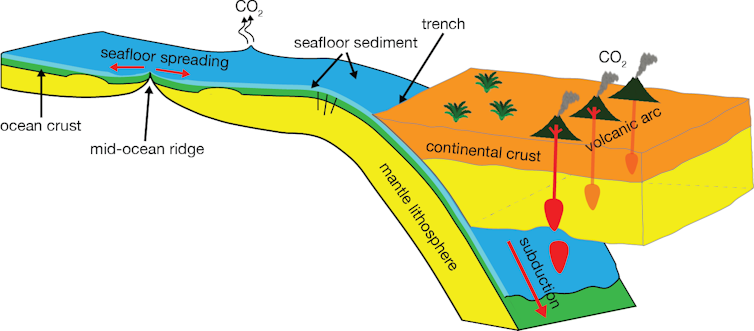In an article summarized at The Conversation, recent research affirms the suite of conditions involving plate tectonics and resultant mountain-building, coupled with erosion and volcanic activity, that has helped to maintain a habitable climate on our planet.
For hundreds of millions of years, Earth’s climate has warmed and cooled with natural fluctuations in the level of carbon dioxide (CO₂) in the atmosphere.
Our new research published in Nature, shows how tectonic plates, volcanoes, eroding mountains and seabed sediment have controlled Earth’s climate in the geological past. Harnessing these processes may play a part in maintaining the “Goldilocks” climate our planet has enjoyed.
To better understand how tectonic plates store, move and emit carbon, we built a computer model of the tectonic “carbon conveyor belt”.
The carbon conveyor belt
Tectonic processes release carbon into the atmosphere at mid-ocean ridges – where two plates are moving away from each other – allowing magma to rise to the surface and create new ocean crust.
At the same time, at ocean trenches – where two plates converge – plates are pulled down and recycled back into the deep Earth. On their way down they carry carbon back into the Earth’s interior, but also release some CO₂ via volcanic activity.

Our model shows that the Cretaceous hothouse climate was caused by very fast-moving tectonic plates, which dramatically increased CO₂ emissions from mid-ocean ridges.
In the transition to the Cenozoic icehouse climate tectonic plate movement slowed down and volcanic CO₂ emissions began to fall. But to our surprise, we discovered a more complex mechanism hidden in the conveyor belt system involving mountain building, continental erosion and burial of the remains of miscroscopic organisms on the seafloor.
The hidden cooling effect of slowing tectonic plates in the Cenozoic
Tectonic plates slow down due to collisions, which in turn leads to mountain building, such as the Himalayas and the Alps formed over the last 50 million years. This should have reduced volcanic CO₂ emissions but instead our carbon conveyor belt model revealed increased emissions.
We tracked their source to carbon-rich deep-sea sediments being pushed downwards to feed volcanoes, increasing CO₂ emissions and cancelling out the effect of slowing plates.
So what exactly was the mechanism responsible for the drop in atmospheric CO₂?
The answer lies in the mountains that were responsible for slowing down the plates in the first place and in carbon storage in the deep sea.
As soon as mountains form, they start being eroded. Rainwater containing CO₂ reacts with a range of mountain rocks, breaking them down. Rivers carry the dissolved minerals into the sea. Marine organisms then use the dissolved products to build their shells, which ultimately become a part of carbon-rich marine sediments.
As new mountain chains formed, more rocks were eroded, speeding up this process. Massive amounts of CO₂ were stored away, and the planet cooled, even though some of these sediments were subducted with their carbon degassing via arc volcanoes.
This recent research adds another component to effectiveness of the well-known carbonate-silicate cycle, one of many design features of our planet that set Earth apart as uniquely suitable for sustaining life.